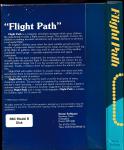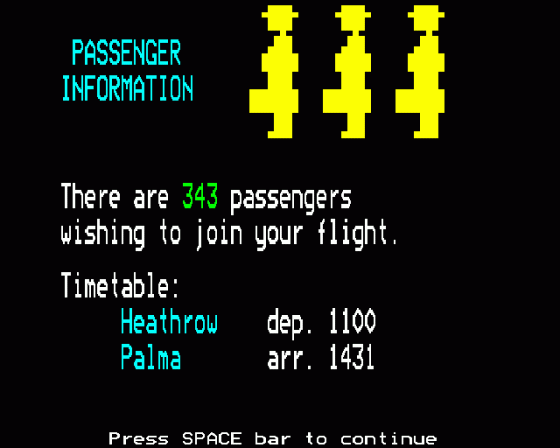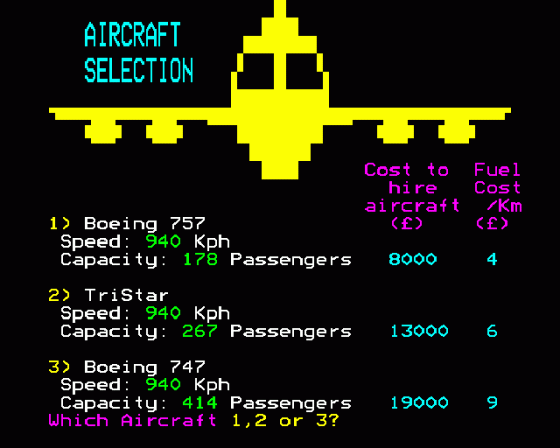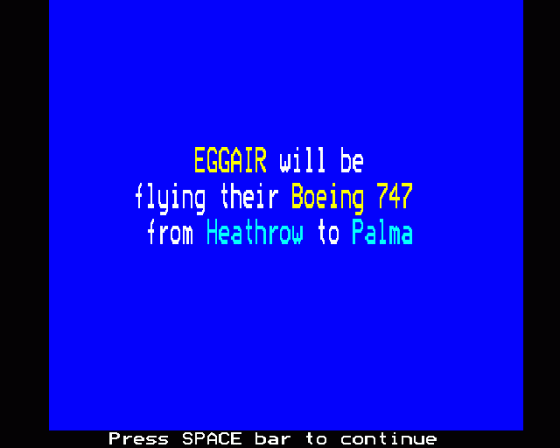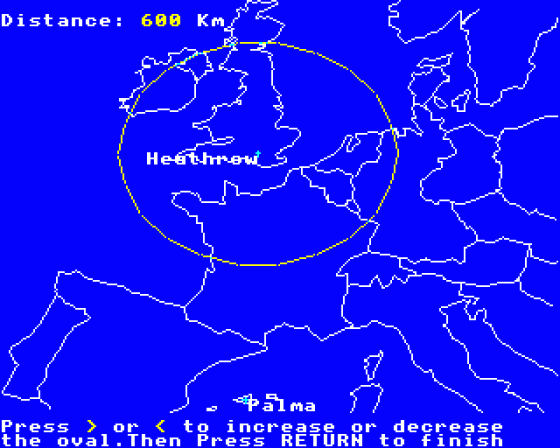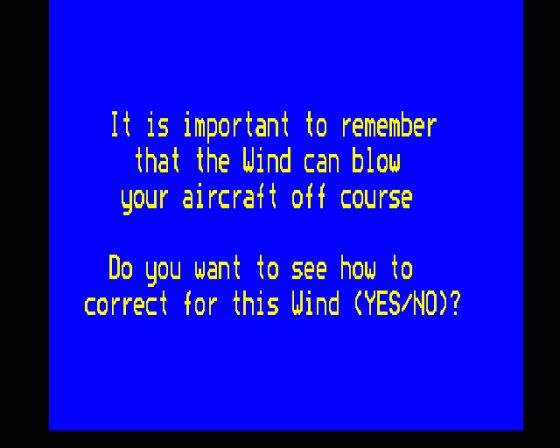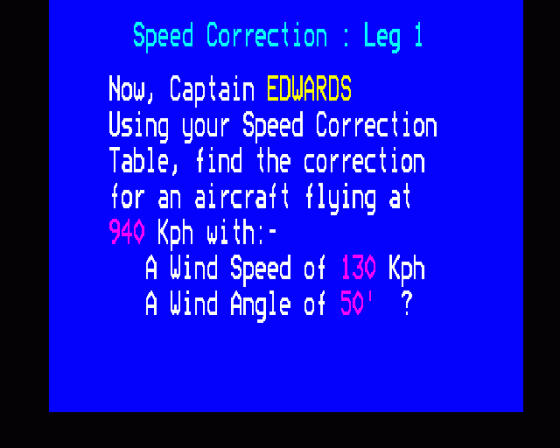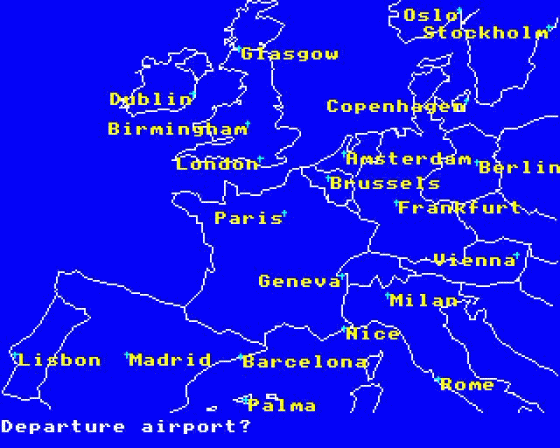
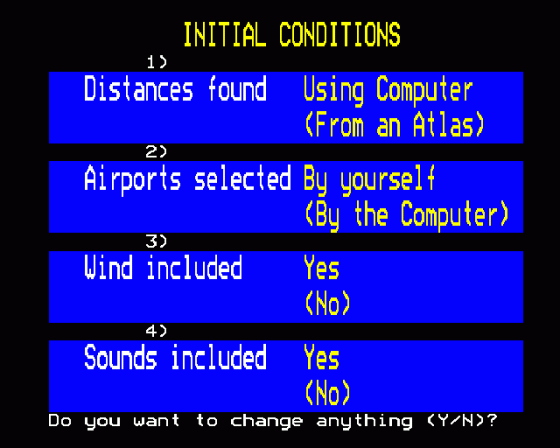
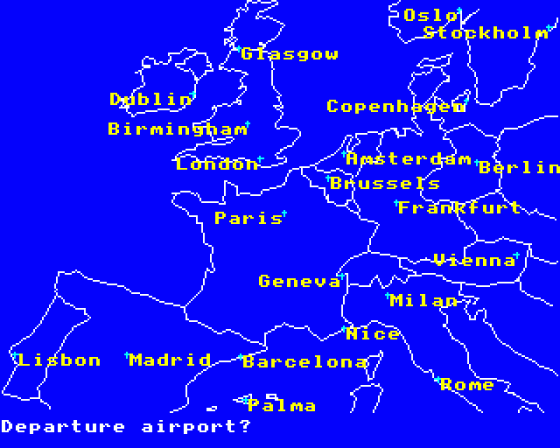
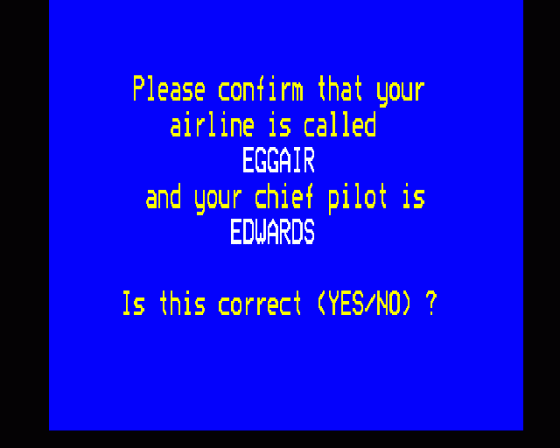
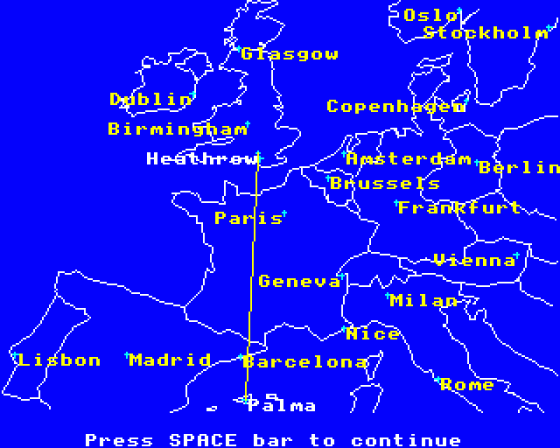
| Genre: | Unknown Genre Type |
| Publisher: | Storm |
| Cover Art Language: | English |
| Machine Compatibility: | BBC Model B |
| Release: | Professionally released on 5.25" Disc |
| Available For: | BBC Model B |
| Compatible Emulators: | BeebEm (PC (Windows)) PcBBC (PC (MS-DOS)) Model B Emulator (PC (Windows)) |
| Original Release Date: | 29th April 1985 |
| Original Release Price: | £20.30 |
| Market Valuation: | £30.05 (How Is This Calculated?) |
| Item Weight: | 220g |
| Box Type: | Oversize clamshell case |
| Author(s): | - |
Variant Items
There are 0 other items featuring this same game (that we know about!). Click any of them for their details.
Active Auctions
Closed Auctions
Buy It
Unfortunately no-one is currently selling this item.
Auction Price Watch
Worried you're being ripped off? Closing prices on eBay can help you decide what a reasonable price is for a particular item.
Components
This item originally came with the following components:
- Instruction Manual
If scans of components are available, you will find them in the Cover Art section.

A&B Computing
1st June 1985
I thoroughly enjoyed this program. It offers decision making, a wide range of skills and concepts, is presented in a very stimulating manner, and the options offered mean that it can be used effectively with a wide ability range. Read Review

Acorn User
1st November 1985
An excellent addition to any school's software selection. Read Review

Home Computing Weekly
26th February 1985
The program is aimed at 10-15 year olds... I'd say it's about £12 worth, not over £20. Read Review
Full Instructions
Flight Path
Flight Path is a computer simulation program which gives children the opportunity to plan a flight across Europe. The program involves the children in making accurate calculations and logical decisions to produce a successful flight.
As Captain, children must select the most suitable aircraft and the number of stop-overs before measuring the range and bearing of each leg of the flight. In addition, they may need to take account of the weather conditions over Europe - possibly requiring course and speed corrections.
Once this has been completed, the moment of truth arrives as their aircraft makes the planning flight. If their calculations are correct, the aircraft will land on target, but if not, the aircraft will crash requiring costly recovery. Finally, a balance sheet will appear to show the airline's profit or loss.
Flight Path will enable children to acquire many new ideas and skills, and involve them in discusssions and decision-making - whilst giving an insight into the world of aviation.
Flight Path may be used by itself or as the focal point of many classroom activities. The package is completed by comprehensive teacher's notes including - course and speed correction tables; Captain's summary work sheet; extensive booklist; suggestions for topics accompanying Flight Path and a range of photographics. Flight Path is suitable for children aged 10-15 years old.
Introduction
Flight Path is a simulation program which gives children the opportunity to plan a flight between any two airports in Europe. By making accurate calculations and taking logical decisions, they are able to 'fly' their chosen aircraft from its departure to its destination airport, making a predetermined number of stops (0, 1 or 2) on the way.
The children take the role of the captain of the aircraft and, in addition to planning the route and taking account of the weather conditions, they have the responsibility for selecting the type of aircraft and the altitude at which it flies.
Having planned the route, by selecting the departure and destination airports, and any stops they wish to make on the way, the children must then choose the aircraft which best suits their needs.
In order for the plane to land in the right place, several calculations must be made.
The distance and bearing of both airports on each leg of the flight; A course correction and a speed correction on each leg of the flight; to compensate for the strength and direction of the wind;
Additionally, most of the decisions takes in the program relate to the cost of the flight. These involve the revenue from passenger fares, the cost of fuel, airport landing charges, a penalty for arriving late, and a rescue charge for landing off target.
Once all the values have been calculated and entered, the moment of truth arrives as the program simulates the flight as planned. This is a very exciting time, giving children a great sense of purpose and, hopefully, achievement. If they have calculated accurately, they will land on target. Otherwise they will be rescued and taken to the next airport en route. However, they will have to pay for the service! If they have made good tactical decisions, they will minimise costs and probably make a profit for the airline.
Flight Path involves the acquisition of ideas and concepts (range, bearings, course and speed corrections, wind angle, profit and loss) and the application of skills (measuring distance, estimating and measuring angles, calculating the time of flight, adjusting for wind in both speed and direction, calculating potential profit). During the program, children are constantly engaged in strategic planning, comparing and contrasting different routes, number of stops, choice of aircraft, and flight altitudes.
"Should we take the biggest aircraft and make no stops on the way, or would we use too much fuel and get less revenue from the passengers?"
"What if we made two stops? Would that mean extra revenue by picking up more passengers at each airport en route, or might we incur a fine for arriving late that would offset this extra income?"
The authors of Flight Path recognise that certain concepts in the program might present difficulties for some children. Consequently, they have included wind and speed tutorials, which present these ideas in a very clear and understandable way. Once they are understood, these tutorials may be by-passed in the main program.
At the end of the program, after the children have had a chance to see how accurate their calculations were, and how 'good' their decisions were, they are presented with a balance sheet. This provides a closer analysis of the various costs involved, and reveals whether or not the airline is in the red!
Finally, the "Captain's Notes" summarise the program by letting the children compare the values they have entered with the 'correct' ones and offers some advice on the decisions they have taken.
In summary, Flight Path gives children an insight into what is involved in planning a flight, and some of the implications for running an airline. In doing so, it provides an opportunity for children to acquire new ideas, apply their skills and make logical decisions, and as such is an excellent vehicle for educational development across the curriculum.
The program is accompanied by summary sheets which allow children to keep a record of their flights. These are useful if children have to leave the program in the middle, if they want to look at previous entries when taking decisions, or for a flight analysis, away from the computer, after the 'flight'.
Flight Path is suitable for children between the ages of 10 and 15 years.
General Description
1. Initial Conditions
At the start of the program there are four initial conditions to be decided:
- Whether the range between airports is found from an atlas, or from the computer's built-in measuring device.
- Whether you, or the computer choose the departure and destination airports.
- Whether or not you want the wind to be a factor in your flight.
- Whether or not you want the sound during the program.
You are asked to enter whether you would like the computer to measure the range between airports or whether you prefer to use an atlas. If you choose to use an atlas, the values you find will be used in the program and you will not be given the opportunity to use the computer's built-in range finger. If you are a little unsure about measuing the page, it is probably better to let the computer help you. You can use the atlas before you do this, and then check your answer with the computer result.
There is also an option here to include, or ignore the effect of the wind. It is suggested that newcomers to the program would do well to ignore the wind on the first run. This will give them the opportunity to get a clear idea of the flow of the program. Inclusion of the wind at a later stage will add a new and interesting dimension to using the program.
The last option in this section allows you to watch off the sound effects. These are minimal and occur either, when the aircraft is flying across the screen, or when you receive passenger information.
2. Airline And Captains' Names
Any names are acceptable as long as they are less than seventeen characters long.
3. Destination And Departure Airports
You are presented with a map of Europe and asked to choose a destination and departure airport from a choice of twenty-one European airports. No other airports will be accepted, even if they exist in reality.
Should you choose London, a further choice between Heathrow and Gatwick will be offered. This choice is offered to stimulate discussion on the reasons why London has two airports: What use have the two airports? Do other cities have more than one airport? Gatwick and Heathrow cannot be selected directly.
4. Passenger Information
You will be given the number of passengers boarding the aircraft at the departure airport for the destination airport and the scheduled departure and arrival times. This information should be written on the worksheet for future reference.
5. Aircraft Choice
You are given a choice of three aircraft:
- A Boeing 747
- A Tristar
- A Boeing 757
Each aircraft flies at the same speed (940 kph) but they have different seating capacities, they cost different amounts to hire, and the cost of fuel per km varies.
These factors need to be considered carefully before you choose an aircraft. For example, you might opt for an aircraft that has a large capacity so that you will get extra revenue from picking up passengers at stop-over airports.
6. Spare Seats And Number Of Stops
You may want to make one or two stop-overs on the way to your destination airport in order to fill spare seats on your aircraft, and to earn extra revenue.
This extra revenue must be set against additional landing charges and fuel costs. However, if you make too many stops, you could incur a fine for arriving late at your destination airport. This fine is a function only of the income of the passengers travelling from the departure to destination airports. You are not guaranteed to use all the spare seats, but if you choose two stops, rather than one, you are more likely to do so.
If you decide to make one or two stops, the map of Europe will be presented, from which you make your choice. Sometimes you may want to make a stop en route but when you enter the name of the airport you get a message that it is not on the flight path. The program does cater for all reasonable flight paths but, should one of your stops come outside this range, you can still enter it by ignoring the error message and typing the airport name in again.
When your choice has been made, you will be told how many extra passengers wish to fly from the departure airport to each of the stop-overs. Later on in the program, you will receive further information about the number of extra passengers that board the aircraft at stop-overs, and who may wish to get off at any of the remaining airports en route. This information comes immediately before the aircraft takes off on each leg of the flight, and it is part of the challenge of the program to keep tabs on all these passengers. If you are careful, you will be able to calculate exactly how much income you will receive from the passengers. However, you must make sure that you base calculations on the actual distance travelled by each passenger.
7. Finding The Range And Bearings
To find the distance between airports you are given a choice between using an atlas (you will need a good one and your measurements will have to be accurate to within 50 kilometres) or you can use the computer's built-in measuring device. This consists of an oval, with its centre at the airport you are measuring them. You simply increase, or decrease, this oval by pressing > or < until the perimeter passes through the second airport. The distance is automatically recorded for you in the top left hand corner of the screen. After pressing RETURN, this is the value you enter.
Bearings are more difficult to calculate so you can use the computer to help you with a measuring device similar to the one used with the range. With one line pointing due North, you turn a second line (using > and < again) until it passes through the second airport. The bearing is calculated for you and appears in the top left hand corner of the screen.
You can, of course, calculate the bearing using an atlas, and then check the result in the manner described above.
The whole procedure is repeated for each leg of the flight. If the incorrect range of bearing is entered, you are asked to confirm the value and the second input, right or wrong, is accepted. You will be able to tell soon enough if the values are correct when the aircraft takes off!
It should be noted that the calculated values for range may not be absolutely precise. There is a tolerance limit built into the program of 50km.
8. Wind Tutorial
This section is optional and it demonstrates how an aircraft can be blown off-course by the wind, and how to correct for it.
Firstly, you are shown an aircraft being blown off its due North course by a wind coming from a bearing of 90 degrees (i.e. from the East).
The next demonstration shows a similar effect but with the wind coming from the West. You are asked to say which way the pilot should steer the plane to take account of the wind.
It is explained how this Course Correction is a function of the wind speed and the wind angle.
The Wind Angle is clearly depicted as the angle between the bearing of the plane and the direction *from which* the wind blows.
It is expected that younger children might draw these angles accurately using a protractor and then measure the wind angle. Older children may be ready to calculate them using simple geometry.
It will be seen that the wind angle is always less or equal to 180 degrees.
A further demonstration shows how to look up the course correction in your table, given particular values for wind angle and wind speed. The wind angle, in the course correction table (and in the speed correction table) is given in 10 degree intervals. The normal convention may be adopted of rounding up if the calculated value is greater than, or equal to, half a particular interval. Otherwise you round down. e.g.
A wind angle of 93 becomes 90
A wind angle of 125 becomes 130
A wind angle of 137 becomes 140
Lastly, you are asked to amend the bearing of the aircraft taking account of the course correction. This will mean increasing, decreasing, or leaving the bearing as it is. If the wind angle is zero, no course correction will be asked for.
9. Weather Report
The flight details for each leg are shown and you are asked to choose an altitude to fly at, given a choice of wind speeds and directions. There are four altitudes to choose from:
4000,6000,80000 or 10000 metres
with corresponding wind speeds and directions.
Although in general, the higher you fly, the less fuel you use as the air is thinnner and offers less resistance. You will need to select your altitude carefully as an inappropriate choice might result in more fuel being consumed (because of a head-on wind, for example) or in a time delay, for the same reason.
After choosing the particular altitude at which you want to fly, you are then asked where you think the wind strikes the aircraft. It is recommended that children sketch diagrams here and there to help them, but you can get help, if required, from the computer.
In order to find the course correction for a particular leg of the flight, you will need to calculate the wind angle. The program helps you here by clearing showing the wind angle as the angle between the direction *from which* the wind blows, and the bearing of the aircraft. It does this for the particular values of wind direction, and aircraft bearing on each leg of the flight.
Having found the wind angle, you are asked to look in your course correction table to find the correction for this wind angle and the wind speed on this particular leg of the flight.
Finally, you must adjust the aircraft's bearing to take account of this course correction. Remember that the pilot must always steer into the wind to compensate for its effect.
The whole procedure is repeated for each leg of the flight.
10. Speed Tutorial
A short demonstration shows how the wind can either have a speeding-up effect, a slowing-down effect or no effect at all, depending on which direction it is blowing from.
A Speed Correction needs to be made to take account of the wind and, once again, this is a function of the wind angle and the wind speed.
You are shown how this can be done and a speed correction is found for a particular combination of wind speed and wind angle.
Once this section is fully understood, like the wind tutorial, it can be bypassed by the main program.
11. Speed Correction
You are asked to look up the speed correction in your table, given the values for the wind angle and wind speed. Children should be encouraged to study a diagram of how the wind affects the aircraft, but should the wrong answer be entered, the correct one will be given. Where the wind operates against the aircraft, the correction is given as a negative number and will be subtracted from the speed of the aircraft. It should be remembered at this stage, that an alteration of speed will affect both fuel consumption and time of arrival.
12. The Flight
For each leg of the flight, a section of the map is drawn on the screen with the departure and destination airports marked. On pressing the space bar you will see the aircraft take off, and fly according to the values you have calculated and entered. You will either make a perfect landing at your destination airport, or you will 'crash' some distance from it.
If you do make a perfect landing you will then receive a balance sheet for this leg of the flight, and you will then proceed to the next leg. Should you 'crash', your balance sheet will include a recovery cost based on the distance from your intended destination.
A summary balance sheet will appear when you finally reach your destination.
13. The Balance Sheets
For each leg of the flight these will give you the following figures:
- The revenue for each passenger based on the actual distance they have flown.
-
The cost of fuel for the flight.
This is calculated from the cost of fuel per kilometre, and, of course, can be affected by a speed correction (a strong wind pushing the aircraft forward can save fuel, whereas a strong head-on wind, will make the aircraft use more fuel). Flying at a higher altitude (where the thinner air offers less resistance to the aircraft) also conserves fuel. - A landing charge at each airport. This is the same for all airports.
- A rescue charge if you happen to 'crash'.
- A 'fine' if you arrive late at your destination airport.
The time for the flight is made from the actual flying time, the turnround at each airport stopped at en route, and the time for any rescue operation.
When you arrive at your final destination airport, the program will show an "Overall Balance Sheet" giving the overall profit or loss. This is made up of the original cost of hiring the aircraft, and the profit or loss made on each leg of the flight.
Educational Implications
Recent trends in education have stressed the importance of providing a curriculum that both highlights the interrelatedness of different areas of knowledge, and matches the needs, interests and capacities of children. Primary teachers, in parrticular, have actively sought to do this by providing first-hand experiences for their children. Quite often, however, this has not been possible because the experiences are too dangerous, difficult, time-consuming, or expensive to embark upon. The arrival of the micro on the educational scene has allowed teachers to go some way towards overcoming these problems, by providing a means to present children with purposeful activities which simulate real-life situations.
A good simulation can do many things:
It can provide the opportunity for small groups of children to work co-operatively and thus develop social skills.
It can encourage language development by stimulating purposeful discussion within these groups.
It can allow for the acquisition of new concepts, ideas and skills, as well as the application of those previously acquired.
It can stimulate children to think logically and make strategic decisions in a realistic problem-solving, or investigative, environment.
It can be fun to use and hence provide a great deal of motivation for children.
As well as providing educationally valid activities at the computer, a good program should actively encourage even more work away from it. The authors of Flight Path hope very much that it will be used in this way and they have provided a suggested list of topics which may support, or be supported by, the program.
Flight Path was produced with the above criteria very much in mind, and it is hoped that both teachers and children will share in the authors' excitement at the finished product.
Loading
Tape: CHAIN"" (RETURN)
Disc: SHIFT-BREAK
Game Credits
(c) 1984 Storm Software, Newbury Cort, Gillingham, Dorset SP8 4QX. Tel: 07476 2774. Telex: 46534 (ALPHAB G)
Miscellaneous
This game was mentioned in the following articles:
Screen Designers
The following utilities are also available to allow you to edit the supplied screens of this game:
Cheats
Download
A digital version of this item can be downloaded right here at Everygamegoing (All our downloads are in .zip format).
| Download | What It Contains |
|---|---|
| A digital version of Flight Path suitable for BeebEm (PC (Windows)), PcBBC (PC (MS-DOS)), Model B Emulator (PC (Windows)) |
Report A Problem
We thank you from the bottom of our hearts if you report something wrong on our site. It's the only way we can fix any problems!
You are not currently logged in so your report will be anonymous.
Add Note
Release Country
Change the country to update it. Click outside of this pop-up to cancel.
Scan Of Selected Article
If you auction an item, it will no longer show in the regular shop section of the site.




